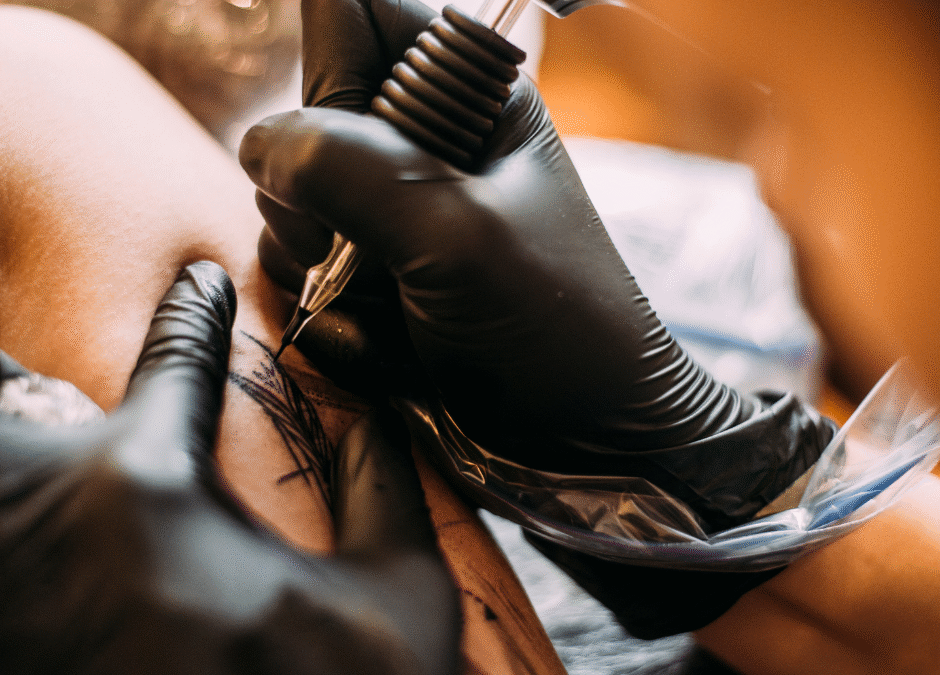How Tattoo Ink Works
When a tattoo artist punctures your skin with a needle, tiny ink particles are deposited into the dermis—the second layer of skin beneath the epidermis. This area is ideal because it holds the pigment permanently while reducing the likelihood of fading or shedding. Your immune system then tries to break down the ink particles, but because they’re too large, they remain in place, giving tattoos their longevity.
What’s in Tattoo Ink?
Tattoo ink is composed of two main parts:
1. Pigments

These give the ink its color. They can be made from:
- Metal salts (e.g., iron oxide for red/brown, titanium dioxide for white)
- Plastics or synthetic compounds (often used for bright, modern hues)
- Organic materials (like carbon black or vegetable-based dyes)
Each pigment has its own chemical makeup, and some may be more reactive than others.
2. Carriers
These are liquids that transport the pigment and help with application and sterilization. Common carriers include:
- Distilled water
- Ethanol or alcohol
- Glycerin
- Witch hazel
Carriers also prevent clumping and deliver the ink evenly into the skin.
Common Tattoo Ink Colors and Their Ingredients

- Black: Carbon or iron oxide
- Red: Cinnabar (mercury sulfide), naphthol, or cadmium red (can cause allergic reactions)
- Blue: Cobalt compounds
- Green: Chromium oxide or verdigris
- White: Titanium dioxide (may fade or turn yellow over time)
- Yellow: Cadmium yellow or curcumin (some UV-reactive pigments)
Note: Some of these ingredients, particularly heavy metals, are regulated or banned in certain countries due to health concerns.
Health and Safety Concerns
1. Allergic Reactions
Red and yellow inks are more likely to trigger allergic responses like rashes or swelling.
2. Toxicity and Carcinogens
Some pigments may contain trace amounts of carcinogenic substances or heavy metals. Although most reputable manufacturers comply with safety standards, regulation varies globally.
3. Skin Sensitivities and Infections
Unsterile ink or equipment can cause bacterial infections or transmit diseases. Always verify that your artist uses approved, sealed, and sterile inks.
How to Choose Safe Tattoo Ink
- Research brands that comply with FDA (U.S.) or REACH (EU) safety guidelines.
- Ask your artist about the inks they use—reputable professionals will know their products.
- Look for vegan-friendly or organic ink options if you have allergies or ethical concerns.
Can Tattoo Ink Fade or Change Over Time?
Yes. Factors like sun exposure, immune response, and ink composition can cause tattoos to fade, blur, or change color. White ink, in particular, is prone to yellowing, and some pigments may degrade under UV light or during laser removal treatments.
Future Trends in Tattoo Ink
- Biocompatible inks: Designed to reduce inflammation and allergic reactions.
- Organic and plant-based options: More demand for eco-friendly alternatives.
- Glow-in-the-dark or UV-reactive inks: Aesthetic innovations with safety still under study.
Conclusion
Tattoo ink may seem like a simple splash of color, but its chemistry is far more complex. Understanding what’s being placed into your skin is essential for making informed, healthy choices. Before your next tattoo, take a moment to ask about the ink—you’ll wear it for life.




